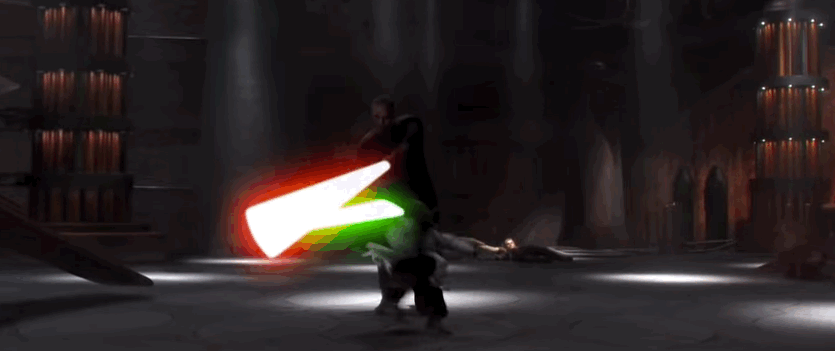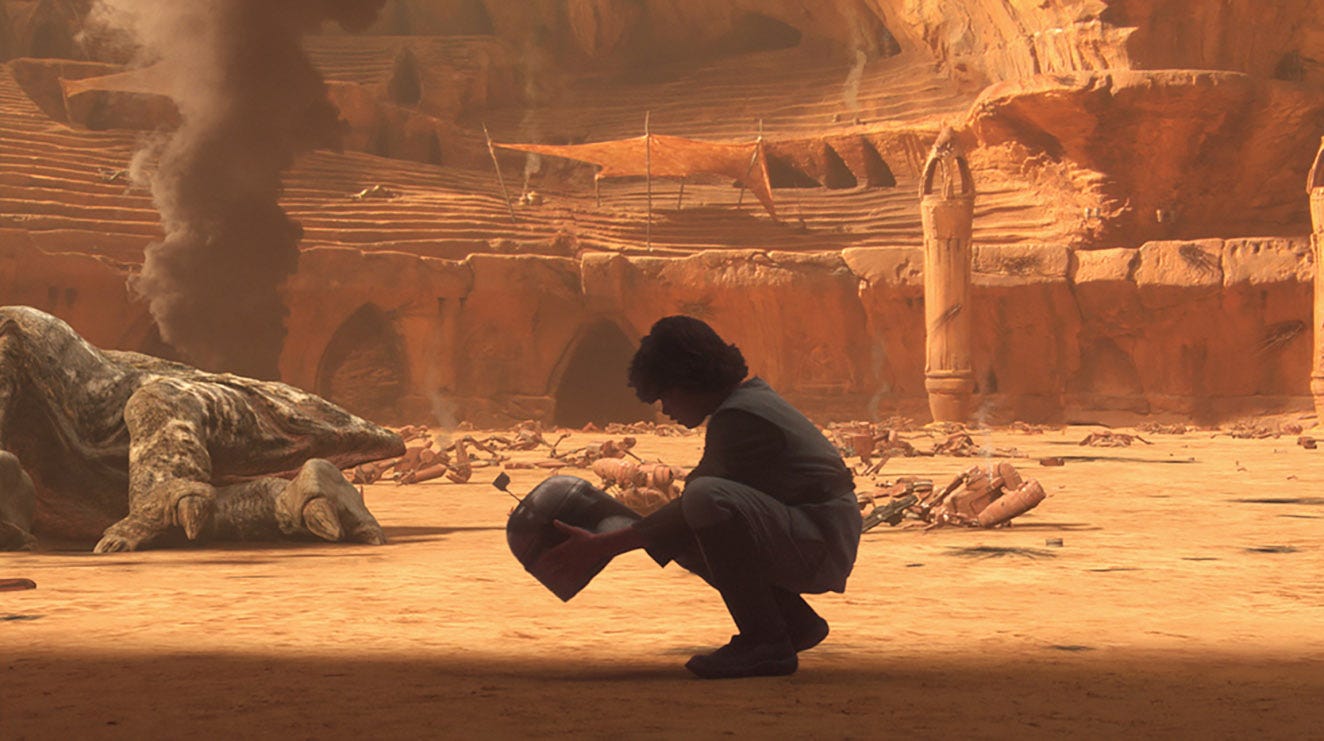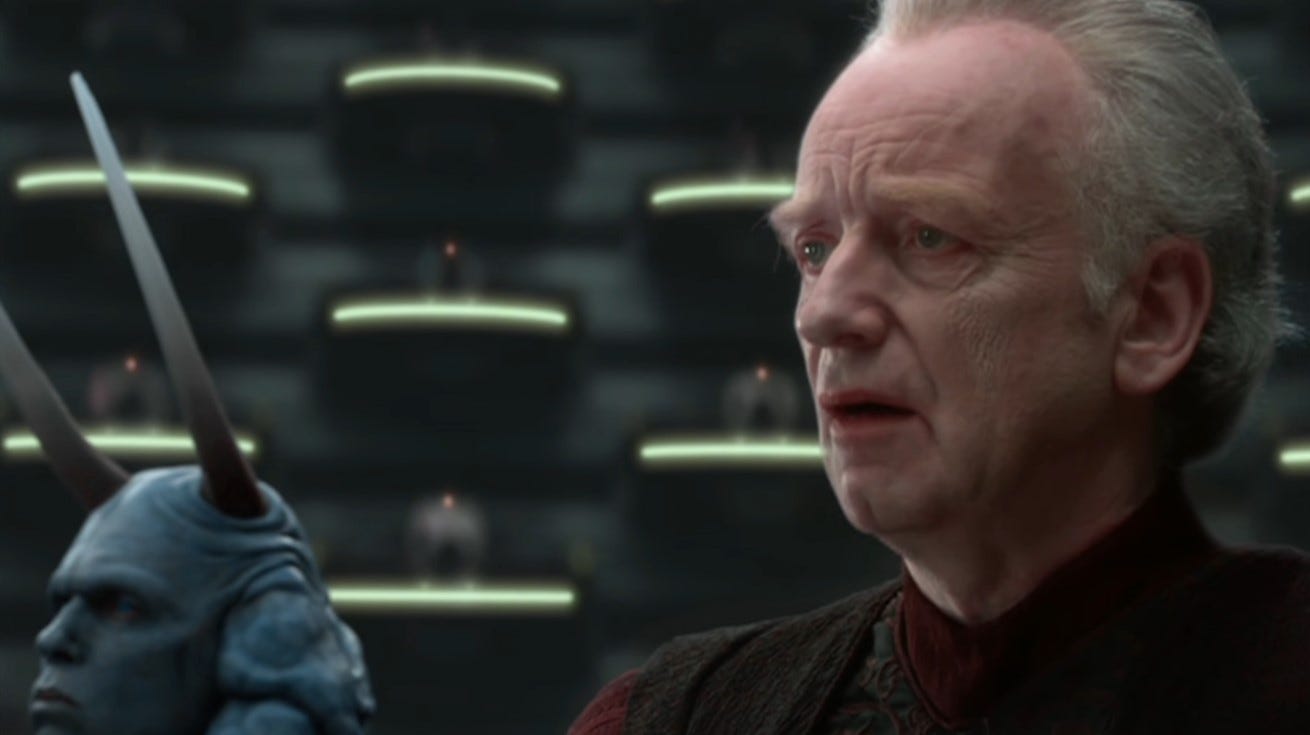In the excellent, revealing behind-the-scenes documentary The Beginning: Making Episode I,1 there’s an ominous moment of realization between George Lucas and Yoda puppeteer Frank Oz.
Oz, seeing a character being digitally animated on a monitor, half-jokingly tells the director, “You don’t need me anymore.”
Flash-forward a few years to 2002, when Star Wars: Episode II- Attack of the Clones was released, and these words couldn’t be truer. Like Lucas, the short green Jedi Master, while still voiced by Oz, has a new-found freedom in this near-fully digital filmmaking frontier.
Yoda’s climactic battle with the Sith Lord Count Dooku (Christopher Lee) is the highlight of the movie. Here, the aging swamp puppet of the original trilogy can pull out a lightsaber and hop around in full view. He leaps over his opponent’s head with abandon, a breathtaking if too brief combative dance. There are similar jolts throughout this sporadic follow-up to The Phantom Menace2, though none of them as captivating or purely entertaining.
Each installment of The Prequels has an evolving sense of aesthetic liberation; the first was shot both digitally and on film, while Episode II is the first big-budget Hollywood production shot entirely digitally. Lucas waited for the special effects capabilities to catch up with his vision so he could cash in his cultural goodwill for this more complex, more intricately and overtly political story.
There was a backlash to these movies when they were first released, something that Attack of the Clones (and Hayden Christensen) bore the brunt of. Many of these criticisms amounted to: Corny writing, wooden acting, too much romance.3
Did we watch the same Original Trilogy? Have you listened to some of that dialogue, or the way it’s delivered? Several of the performances, particularly in the original, aren’t what I would call wooden but they aren’t what I’d call good, either.4
Sure, you can attribute these criticisms to Lucas’ lack of skill as a scribe or in his actors’ inability to sell some of their exchanges. I also attribute it to his fundamental disinterest in dialogue and performance as anything other than functioning cogs in a fuller picture. It doesn’t excuse some of the end result, but like Lucas, I’m just not as interested in the art of acting when it comes to something like Star Wars.5
Instead, he has always been laser-focused on marshaling whatever resources he has at his disposal to push the technology of the artistic medium forward. In that respect, the green screen proved to be a more freeing canvas for him than any of the groundbreaking special effects work in the Original Trilogy.
Here, he creates lively artificial backdrops for a slew of disparate planets. There are the endless cityscapes of Coruscant, increasingly overrun with noirish shadows; the crashing blue and black waves that conceal massive, blindingly white corporate secrets on the water world Kamino; and more coarse, rough, irritating sand on the desert planets Geonosis and Tatooine.
I think the most interesting aspect of The Prequels is that Lucas takes his classic filmmaking influences and his untethered sense of visual freedom and marries it to an increasingly dark and despairing sci-fi story about the corruption of innocence and the rise of fascism.
Audiences knew going into these films that they would chronicle Anakin Skywalker’s corruption by the Dark Side and transformation into James Earl Jones Darth Vader.
What caught many people off guard, though, was the vast political machine Lucas devised here. A galaxy marred by trade disputes, ceremonial treaty negotiations, and endless bureaucratic failings is not nearly as easy a sell as the simpler story of Rebellion vs. Empire.
Attack of the Clones takes the conflict of the first film a level deeper, showing the continued pull of Sith Lord Darth Sidious/Chancellor Palpatine (Ian McDiarmid).6 In showing how he manipulates both sides of an escalating conflict, Lucas creates a startlingly prescient mix of corporate fascism- the subdued but still racist caricatures of the Trade Federation- and blind neoliberalism- the Republic’s Galactic Senate and Jedi Council.
These forces come to a head on Geonosis during the large-scale battle at the end of Episode II. As the Trade Federation’s battle droids and the Republic’s newly minted, Jedi-led clone army collide, it’s an amalgamation of computer-generated dust and lasers. It’s totally artificial, just like the feigned conflict Palpatine orchestrates to seize power.
If the climax of Attack of the Clones is less grandiose than the 4-pronged action sequences that conclude Phantom Menace, it’s much more instructive on the direction blockbusters would take going forward. Lucas and other directors have been able to create fully digital mass-market art, but the technological advancements that this trilogy paved the way for have largely been used to create indistinct, ugly CGI slop.
Is that Lucas’ fault? Partly, sure, but I’m not really interested in an Oppenheimer-level examination of his culpability. After The Prequels, it became clear that he would never be able to make Star Wars movies with total creative control again. The fandom was in need of servicing, not whatever this was. So he sold it to Disney for a couple of billion dollars.
They may not have known it yet, but these fans yearned for the House of Mouse’s Art by Committee model that would dominate Star Wars (and Marvel, Pixar, et al) in the 2010s. They craved the nostalgia-tinged return of Han, Leia, and Luke7, and an over-abundance of merchandise-ready creations like Baby Yoda,8 not “The Trade Federation” and “The Galactic Senate.”
In essence, fans wanted simplicity back. And by and large, they’ve gotten it.9
Attack of the Clones is streaming on Disney+.
I will accept arguments about the first two but saying a movie has too much of a love story is loser behavior.
Please, go listen to every Mark Hamill line delivery in the original Star Wars. I’ll wait! (I do love the first two films in the Original Trilogy, for the record).
Ian McDiarmid, Samuel L. Jackson, and Christopher Lee understand the assignment, to be clear.
I’ve always found it comical how little Palpatine’s identity is concealed. He throws a black cloak on and suddenly everyone is like, “Wow! That is a totally different person and his name is Darth Sidious!”
At least in The Force Awakens. There was another fan revolt over the other two entries in the latest trilogy, which I’m not spending time on here.
Star Wars films, Lucas’ included, have always been savvy about turning creatures and gadgets into lucrative toys for children.
‘Imperial March’ grows louder






